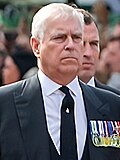This article contains historical images which have been upscaled using AI .(December 2024) |
| Barony of Killyleagh | |
|---|---|
| Creation date | 23 June 1986 |
| Creation | First |
| Created by | Elizabeth II |
| Peerage | Peerage of the United Kingdom |
| Present holder | Andrew Mountbatten-Windsor (not using title) |
| Remainder to | the 1st Baron's heirs male of the body lawfully begotten |
| Status | Extant, not in use [1] |
Baron Killyleagh is a title in the Peerage of the United Kingdom. It was created on 23 July 1986 by Queen Elizabeth II as a substantive title for her son, the then Prince Andrew (now known as Andrew Mountbatten-Windsor) on the occasion of his marriage to Sarah Ferguson. [2] [3] In November 2025, King Charles III removed Andrew Mountbatten-Windsor's right to be referred to as Prince and to use his titles of nobility. Nonetheless, the title 'Baron Killyleagh' along with Mountbatten-Windsor's superior titles (Duke of York and Earl of Inverness) remain extant in strict legal terms. [4] [5] [6]
The title is named after the village and civil parish of Killyleagh, County Down, Northern Ireland. It is best known for its 12th century Killyleagh Castle.
Traditionally, the monarch grants male members of the royal family at least one title on their wedding day. On the same day, that the then Prince Andrew was awarded the title, he was also created Duke of York and Earl of Inverness. [7] [8]
